#embryo sac
Explore tagged Tumblr posts
Text

The Science Diaries of S. Sunkavally, p 695.
#carbon suboxide#photorespiration#neurotransmitter#glutamate#autonomic ganglia#EPSP#IPSP#blood-brain barrier#embryo sac#triploid endosperm#polyploidy#pollen grains
0 notes
Text
However, in T. fournieri and several other species, the embryo sac grows out through the micropyle toward the funiculus (Figure 21.16). (...) However, if the T. fournieri pollen grains are first germinated on a living stigma and allowed to emerge from the cut end of the style, they do grow toward the micropylar end of the embryo sac (see Figure 21.16F).
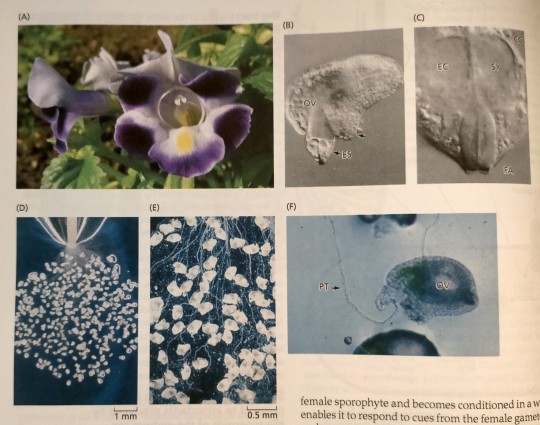
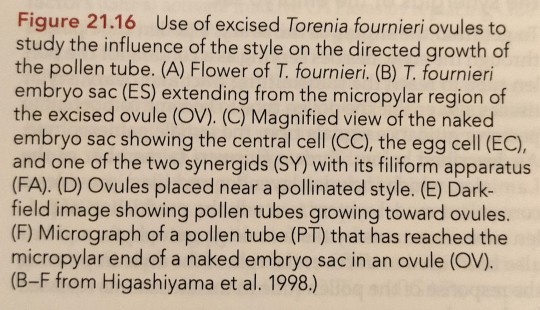
"Plant Physiology and Development" int'l 6e - Taiz, L., Zeiger, E., Møller, I.M., Murphy, A.
#book quotes#plant physiology and development#nonfiction#textbook#torenia fournieri#embryo sac#micropyle#funiculus#pollen#stigma#style#microscopy
0 notes
Text
When the pollen tube senses chemical attractants secreted by the synergids, the tube grows through the micropyle, penetrates the embryo sac, and enters one of the synergid cells.
"Plant Physiology and Development" int'l 6e - Taiz, L., Zeiger, E., Møller, I.M., Murphy, A.
#book quote#plant physiology and development#nonfiction#textbook#pollen tube#chemicals#attractants#micropyle#embryo sac#synergids#plant cells#fertilization
0 notes
Text
Getting Pounded by Nagas PART 3: Contractions
Pairing: Two nagas x human reader
Summary: You wake up feeling pains in your belly, getting ready for the egg birth. The doctor checks on you there is an issue… one that can be resolved only with your mates’ touch and seed.
Warnings: minors don't interact, 18+!!!!, monster smut, inaccurate pregnancy stuff (this is naga egg preg smut, let me have fun), naga smut, double 🍆🍆, double penetr, lots of come. Don’t like, don’t read please.
This is part of a series. Find all the parts here.


It was early in the morning when the contractions jolted you awake. The bedroom was still and dimly lit only the weak rays of the sun filtering through the curtains. You winced and disentangled yourself from between your mates, clutching your swollen belly and taking shallow breaths. The eggs shifted inside you, the pressure too much. Your groaned and the soft sound stirred your mates from their sleep. They woke with gasps of concern.
“What’s wrong, little one?” Ragnor asked, his fingers cradling your belly. You were 12 months along, so close to birth, your stomach round with the two eggs inside you.
“Contractions,” you breathed as another pain rolled through you.
At your words, both of your mates exchanged a look of worry. You were not supposed to have contractions. A Naga pregnancy didn’t have sudden contractions. It was completely different to a human pregnancy. The birth, too. It was the reason you’d arranged everything with the doctor and planned an induction of labor a week from now. But clearly, that plan would change.
“I can feel the eggs moving,” you muttered. “It’s starting to hurt.”
That’s was all you needed to say before your mates sprang into action.
Ragnor prepared everything you would need, packing you bags and a light meal. Meanwhile Thorne helped you take a shower and put on a soft, comfortable dress. In just twenty minutes, you found yourself lying at the padded chair in the Superhuman Maternity and Birthing Center. The room was bright and serene, the smell of disinfectant in the air. Your mates stood on each side of you, their tails wrapping around the chair.
Dr. Elise, a human woman in her fifties entered the private room, dressed in pristine white robes. She was a very kind and experienced doctor who monitored your superhuman pregnancy. Unlike you and your mates, Dr. Elise was calm upon hearing that you had contractions. She reminded you to keep taking deep breaths and trust in her ability to keep you safe.
“Good, very good,” the doctor said once you had calmed down a little. “Let’s take a look at you and the eggs. ”
The doctor used various advanced technological devises to scan your belly, take some blood samples and check the position of the eggs. You waited patiently as she analyzed your samples, winching only slightly when another contraction hit. Thorne and Ragnor stood at your sides, concealing their concern, each of them holding one of your hands tightly.
When Dr. Elise finally completed her calculations, she looked at you and your mates with a reassuring smile. “Everything appears perfect apart from the contractions. Naga pregnancies don’t cause traditional human contractions. That is because the eggs do not implant in the uterine wall like typical mammalian embryos. Instead, they remain free-floating within a specialized sac that develops to accommodate their growth. What you are experiencing now are false contractions.”
“Are my babies okay?” you asked her, tears pricking at your eyes.
Thorne kissed your sweaty forehead while Ragnor your lips. “We’re right here, love,” each of them murmured to you. “We won’t leave your side, relax for us.”
The doctor placed a strange cylindrical LED device over your vagina and ass, “I see that you’re not filled enough with your mates’ seed. It’s why you’re experiencing contractions and pain. We need to make sure you’re completely suffused in seed, and after that, it’s imminent that they be delivered. When was the last time you’ve had intimate relations with your mates?” The doctor asked you.
“Last night,” you answered in one breath.
“We fucked only once because she was sleepy,” Ragnor said, brows furrowing. “Wasn’t that enough?”
Dr. Elise shook her head. “Not in the least. The eggs consume the seed incredibly fast, especially at their current growth,” she explained. “You’ll need to fill your mate again, thoroughly and immediately.”
“Right now?” You asked, your voice pitching without meaning to.
“Yes,” Dr. Elise said. “I want you to be suffused with seed and after that I’ll induce the birth. We can’t risk waiting and risking both your health.”
“We’ll fill her. In both holes, just to be sure,” Ragnor said, his face completely serious.
Dr. Elise nodded. “Yes, and if you can give her seed through the mouth as well, that would be ideal.”
You flushed furiously as your mates and the doctor discussed the details, their faces dead-serious as if talking about filling your holes with seed was the most casual thing in the world.
Dr. Elise noticed your discomfort and smiled gently. “I want you to trust in me and my abilities to bring your babies to the world. Naga birth requires the assistance of the partners even more so in your case because you’re human.”
“Will it hurt as much as a human birth?” you asked, heart palpitating.
The doctor smiled. “No, it will be pleasurable and just mildly uncomfortable.”
You flushed at the word “pleasurable”. You’d discussed the birth plan a long time ago and you remembered the doctor telling you that your mates would need to make you climax during the birth for each egg to be delivered.
“Let me remind you how this will go,” Dr. Elise began, her voice calm. “Once you’re properly suffused with seed, I will give you a medicine that will induce the eggs to come out. Naga eggs have a tendency to like it in the womb and at some cases, they refuse to come out. The eggs will naturally leave your system, do not doubt that. I have specific instructions for that. Trust me, we will go through with it after you’ve been suffused with enough seed.”
“Thank you, doctor,” you said, your cheeks blushing a little.
“It’s my pleasure. Naga birth is completely different from that of a human so I want you to be as comfortable as possible and talk to me and your mates.”
“I understand,” you said. You trusted Dr. Elise and knew she was right. “Where can I and my mates… uhmm… do what we need to do?”
Dr. Elise stood up. “This room is reserved for your birth so you can stay here. I’ll step out to give you privacy and return roughly in two hours. Call me for whatever you need; I will be on standby.” The doctor headed to the door and glanced at your mates, “Remember, you need to fill her completely otherwise her health and the eggs will be at risk. I’ll come back to check, and if it’s not enough, you’ll have to keep going until the eggs have consumed enough seed.”
Once the doctor was out, you slumped back in the chair. “I can’t believe this. My health is dependent on your seed.”
“Lots of it”, Thorne added, looking smug.
“I’m going to be super cocky about that in the future,” Ragnor said, a smug grin on his face.
Two throaty chuckles made you look at your scaled mates. Horny bastards, they had already dragged off their shirts and their cocks had emerged from their protective slits, thick and massive, the cockheads glistening with arousal. You licked your lips and swallowed thickly. This was real. You were about to be fucked right there, in the examination room.
Ragnor wasted no time and slid up your dress, the only piece of clothing you wore. He left you completely naked on the chair, his hungry amber eyes devouring your form. Thorne was gazing at you just as intensely, both your nagas marveling at your swollen breasts, your round stomach and between your legs. You tried to close them, suddenly a little shy, but their tails wrapped around your ankles, keeping them spread wide for them.
“Will you trust us to fill your pretty little holes, little mate?” Thorne asked, his voice a whisper as he claimed your lips.
“Hnnn… fuck, yes,” you said, arching your back, offering yourself to them. The more they touched you, the more the contractions eased, pleasure taking over.
“Damn, what a pretty sight our mate is.”Ragnor lowered his head to your stomach, rubbed the swell, and spoke, "We’ll meet you soon, little ones. Stay safe and warm in there."
“Daddies will take care of mommy,” Thorne drawled, his mouth finding its way to one of your nipples, drawing it into his mouth. It leaked milk and with a groan he lapped it up.
Ragnor lavished attention on your other breast, his fingers teasing and rolling the tip that was beaded with milk. A whimper came tumbling from your lips then a drawn-out moan as they took turns worshipping your leaking breasts.
"Ahh— hnng... need your seed," you rasped, carding your fingers through their silky long hair.
"We need to prepare you mate,” Thorne said while kissing one lush rosy nipple and wetting the other with his tongue.
"I’m ready... ahh... I need your load."
Ragnor hummed. “Our mate is right. We need to fill her tight little holes. Hm?”
Thorne agreed, a smug grin playing on the lips.
Gently, you were lifted and placed onto Ragnor’s embrace. He carried you to the bed nearby and sat with you against his chest, your sensitive breasts leaking. His massive cock throbbed against your belly, slick with precum as you reached out and wrapped your hands around it. With sensual strokes, you pumped him up and down, the intimacy between you and your mates heightening.
You sensed Thorne presence behind you, his sinuous tail reaching for the bottle of lube in one of the drawers. You heard the slurp of lube then felt him take his place behind you, his cock wet against your back. With your free hand, you reached back to stroke his cock while his lubed fingers deftly parted your asscheeks, spread them wide, fingering your tight entrance and rubbing the swollen nub of your clit.
Thorne thrust a finger into your ass while stroking your clit with the other hand. Your thoughts turned into mush and you buckled your hips, the sensations electric. Another finger slid up your tight hole, the hand at your pussy moving with deliberate movements. You gasped and came with the most ridiculous moans, soaking wet and aching for more.
Sensing your need, your mates lifted you, their cocks poised beneath each quivering hole. Ragnor’s double cocks parted the folds of your pussy, his massive veined dicks thrusting upwards. Thorn’s shafts pressed insistently against the tight bud of your asshole. They guided you down until you were doubly impaled by their dicks.
Breath hitching, you squeezed your eyes shut.
You saw stars.
Pleasure and bliss.
They began their rhythmic thrusts and you whimpered, clutching onto their shoulders for dear life as they bounced you up and down on their naga dicks. Your body hummed with pleasure, the contractions barely catching your attention. Your nipples were hard and leaking, your holes clenching and unchecking around the invasions.
Your mates kissed your lips, your neck, your sensitive nipples. Their fingers roamed protectively over your belly, teasing and claiming you as you rode higher and higher. You rocked against them and rode them wildly, your juices leaking down your thighs and all over the cotton sheets.
Two more thrusts and you came crashing around their cocks, relief surging through you. Your naga mates groaned and followed the very next moment, their frames shaking violently as they spurted their seed inside you. The warmth filled you up, bringing immediate relief as the eggs seemed to settle within you.
“That’s it, such a good mate for us,” Ragnor murmured, kissing you softly. “How are you feeling, mama?”
“Better. Much better,” you said, your eyes and voice pleasure-hazed.
“It'll be okay," Thorne whispered into your ear. "Now we’re going to change positions and fill you up again, alright, love?”
You nodded, whining. You’d do anything to keep your eggs safe and you loved and needed your mates just as much.
“Let us take care of everything, love,” Ragnor said, kissing you softly once more.
A wet squelch echoed as the cocks exited your depths. Your mates held you in a way that kept most of their seed inside you, and quickly plugged you up. This time, Ragnor laid down, thrusting his dicks up your ass, while Thorne slid between your splayed legs, draped them over his green-scaled tail and filled your tight pussy. Their tails coiled around your breasts, squeezing them delightfully and making your nipples leak out milk. Thorne lapped it up greedily, while Ragnor reached down to play with your swollen clit.
“Haah, yessss, ahnnn, feels so good,” you moaned as you were worshiped and claimed in every way possible. “Hng-go…go…nna—”
You cried out at the dizzying explosion of yet another climax. Your toes, high in the air, curled tightly, and your hands clung frantically to Thorne, fingers digging into his bare back. Their movements grew frantic, desperate until they buried themselves to the hilt and exploded within you, pumping rope after rope of cum, groaning harshly in masculine satisfaction.
Their strong hands rubbed your belly possessively, feeling the gentle movements of the eggs inside you. They kissed you deeply, tongues intertwining, then rearranged your positions again. This time, you lay on your side between your mates. Thorne spooned you from behind, his tail wrapping around your knees and opening your legs. Growling, he thrusts his fat cocks into your pussy and ass. You were drenched, naga seed all over your mound and thighs.
“I say we fill her pretty mouth, too,” Thorne said, his voice thick with arousal. “I want to see her swallow your seed Ragnor, let it fill her stomach.”
Ragnor groaned and kneeled at your face, his cocks jutting proudly up to his bellybutton. “Open up, love,” he cooed. “We need to make sure you’re completely filled.
Ragnor guided his cockhead to your lips and you opened up, taking one of his dicks as deep as you could in your throat. You suckled his shaft with fervor, your tongue tracing the veiny ridges and swirling over the flared head. Your hands pumped his second cock and you alternated between the two while Thorne pounded into you, causing your tits to bounce.
“Fuck, you have no idea how beautiful you look, mate,” Ragnor muttered, watching your mouth, now filled with both his cocks, while Thorne’s dicks pistoned inside you.
“Mffgh— love—hffuh you,” you gurgled around the shafts in your mouth, wet slurping sounds filling the room.
“We love you, too, precious mate,” Throne said, hips snapping repeatedly, driving his shafts deep in your depths. “You’re doing great. We’re almost there. Just a little more, love.”
They settled into a sensual rhythm, Ragnor’s cock filling your mouth while Thorne thrust inside your pussy and ass, his hands gripping your hips to keep you steady. They whispered sweet nothings, their voices thick with praise and adoration: ”you’re doing so well”, “our brave, beautiful mate”. They caressed your tummy, pinched your breasts while their tails flicked your poor clit.
Little sparks of fire sizzled through your body and burned you up in a blissful climax. You trembled and writhed, and Ragnor withdrew his cock allowing you to cry out with ease. Thorne’s magnificent serpent body bucked and he came with a bellow, nipping at your shoulder while pumping his seed inside you. Once he was done, Ragnor slid back in your mouth, his fingers grasping your hair. He thrust once, twice and came, cocks pulsing with his release. You swallowed every single drop, and felt his hot load fill your belly.
“Damn, mate, you took all we had to give,” Thorne said affectionately, his cocks still nestled within you, plugging up the seed.
“Our mate is the strongest,” Ragnor said, kissing you passionately, his tongue tasting his seed in your mouth. “How are you feeling? The eggs?”
“I’m feeling… perfect,” you said with a soft smile. “The contractions are almost gone. When will the eggs come?”
Just in time, a knock echoed through the room. The doctor had returned and you would soon give birth to your eggs.
Any kind of support will make me smile so big! Feel free to share your thoughts and reblog! Next part will be the birth.
#naga x you#nagas x reader#nagas x you#naga x reader#naga x human#naga smut#monster x reader#monster x you#monster fucker#monster lover#monster x human#monster smut#monster x female#monster x female reader#monster boyfriend#monster fudger#monster romance#teratophillia#terat0philliac
1K notes
·
View notes
Text
Round 3 - Chondrichthyes - Carcharhiniformes




(Sources - 1, 2, 3, 4)
Carcharhiniformes, commonly known as “Ground Sharks”, are the largest order of sharks. They include the families Scyliorhinidae (“catsharks”), Atelomycteridae (“coloured catsharks”), Pentanchidae (“deepwater catsharks”), Dichichthyidae (“bristle sharks”), Pseudotriakidae (“false catsharks”), Proscylliidae (“finback catsharks”), Leptochariidae (“Barbeled Houndshark”), Triakidae (“houndsharks”), Hemigaleidae (“weasel sharks”), Carcharhinidae (“requiem sharks”), Galeocerdonidae (“Tiger Shark”), and Sphyrnidae (“hammerhead sharks”).
Due to being such a large order, Carcharhiniformes are very diverse. Scyliorhinid catsharks (image 4) are distinguished by their elongated, cat-like eyes and two small dorsal fins set far back. They are usually small, with a patterned appearance, ranging from stripes to patches to spots. Carcharhinids are migratory, live-bearing sharks of warm seas (sometimes of brackish or fresh water) and include some of the most familiar species, such as the Bull Shark, Lemon Shark, Blacktip Shark (image 2), and Whitetip Reef Shark. The large-bodied, striped Tiger Sharks (image 3) are the only living members of their family Galeocerdonidae. The most distinctive family in this order is possibly the Sphyrnids, the Hammerhead Sharks, which range from the omnivorous Bonnethead Shark to the bizarre Winghead Shark to the giant Great Hammerhead (gif below).
The Carcharhiniformes arose in the Middle Jurassic, and were morphologically similar to living catsharks. They did not attain their modern diversity of forms until the Late Cretaceous, and didn’t reach medium and large body sizes until the Cenozoic.

Propaganda under the cut:
The Bonnethead Shark (Sphyrna tiburo), a small species of hammerhead, is the only shark known to be omnivorous. While it feeds on crustaceans, molluscs, and small fish, it also ingests large amounts of seagrass, which has been found to make up around 62% of gut content mass.
The "Swell Sharks" of the genus Cephaloscyllium have the curious ability to fill their stomachs with water or air when threatened, increasing their girth by a factor of one to three.
Some catsharks, such as the Chain Catshark (Scyliorhinus retifer), are biofluorescent.
The Slender Smooth-hound (Gollum attenuatus), is the only ground shark species known to exhibit intrauterine oophagy, in which developing fetuses are nourished by eggs produced by their mother. They will form egg capsules which contain 30-80 ova, within which only one ovum develops; the remaining ova are ingested and their yolks stored in its external yolk sac. The embryo then proceeds to develop normally, without ingesting further eggs.
The oddly shaped head of hammerhead sharks is called a cephalofoil, and is used for hunting. Numerous electroreceptory organs are located on the underside of the cephalofoil. The hammerhead will swing their head in broad angles over the sea floor to pick up the electrical signatures of stingrays buried in the sand. The cephalofoil also serves as a hydrofoil that allows the shark to quickly turn around and strike at a ray once detected. It may also pin it down with its head while pivoting to take a large bite from each side of the ray's pectoral fin disc.
The Tiger Shark (Galeocerdo cuvier) is one of the biggest predatory sharks, with exceptionally large females reaching over 5 m (16 ft 5 in). Males are much smaller, with only the largest getting up to 4 m (13 ft 1 in). They are apex predators and scavengers, with a reputation for eating almost anything. They are eaten by orcas and humans, also apex predators with a reputation for eating almost anything.
Tiger Sharks possess unique significance as ‘aumākua, revered as family guardians in Hawaiian culture. The tiger shark, regarded as an intelligent and highly perceptive spiritual entity, assumes the role of a messenger bridging the gap between humans and the divine.
During a 2015 expedition, an international team found two species of Carcharhiniform shark, along with microbial communities, living within the underwater crater of the active volcano Rejo te Kvachi, now informally dubbed “Sharkcano”. Using a baited drop camera, an international team observed Scalloped Hammerhead Sharks (Sphyrna lewini) and Silky Sharks (Carcharhinus falciformis) living in the hot, acidic water.
Many of the sharks in this order are endangered due to overfishing, both as bycatch and purposefully for shark fin soup. Critically endangered species include the Pondicherry Shark, Daggernose Shark, Great Hammerhead, Scalloped Hammerhead, Scalloped Bonnethead, Ganges Shark, Striped Smooth-hound, Oceanic Whitetip Shark, Borneo Shark, Whitefin Swellshark, and Whitefin Topeshark. The Lost Shark may already be extinct.
#man I’m going to have to wade through a lot of upsetting dead shark photos to find good ones aren’t I#anyway i have been copy pasting the bonnethead shark fact since round 1 and i am now determined to carry it with me as far as possible#Round 3#Animal Polls#Chondrichthyes
109 notes
·
View notes
Text
The whole time watching Scavengers Reign I was seeing that white lily and I was like ‘okay cool, this represents death’ (see them growing on corpses in the first few episodes and all the fields of them at the beginning of episode 10). BUT in episode 11 they’re shown alongside Levi’s rebirth. So I was like, ‘okay cool, they’re representing death AND life’ and then in episode 12 they’re like little amniotic sacs for the robot embryos so it’s life AND death AND they’re just a little fucked up and that’s kind of the point of the whole show and that’s incredible
#scavengers reign#levi scavengers reign#sam scavengers reign#this show is so fucking good#pleaaase watch it
451 notes
·
View notes
Note
If hywari don't have a navel, then how do they feed in the womb?
(if this is a stupid question, then please don't answer...)
I have no idea, lol, and I don't think Blastic has ever thought about it either. It was probably just a design choice 🤷
Who knows, maybe - like some reptiles and birds - the embryo develops with an internal yolk sac that provides all the necessary nutrients for development. This yolk sac could be absorbed over time as the baby grows 🤔
Just an idea :D
113 notes
·
View notes
Text
Monday Musings: The Might of the Amniotic Egg
So far, we've learned about the earliest vertebrates and fishes and how one branch of those fishes grew legs and became the first amphibians but something even more amazing happened during the Carboniferous Period: the amniotic egg.
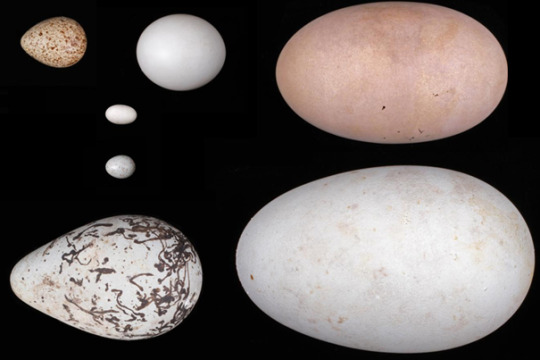
What is an amniotic egg? It is an egg that is adapted to retain water without needing to be in water. In other words, an egg with a shell (either soft or hard). Of course, just like living on land required more than just legs, amniotes (animals that produce an amnion) needed more than just a protective shell.
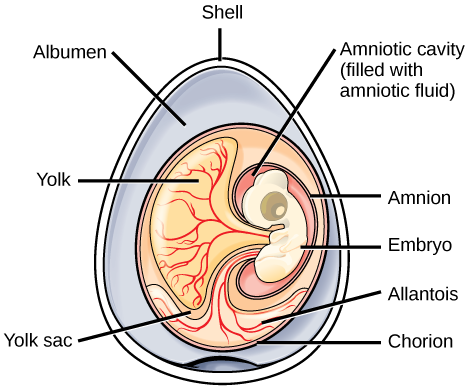
Fish and amphibians only have one inner membrane, the embryonic membrane. Amniotes have four: the yolk sac which surround the yolk, the amnion which surrounds and cushions the embryo, the allantois which helps with gas exchange and waste removal (becomes the umbilical cord in mammals) and the chorion which is the outer most membrane and surrounds everything.
Amniotes also lack otic notches because they are fully terrestrial (yes, some are secondarily aquatic but that is for a later discussion). Instead, they have extra holes in their heads for muscle attachments and to lighten the weight as amniotes can grow quite large.
Anapsids are the ancestral condition. These early amniotes lacked the temporal fenestrae that the other two groups have. Turtles are anapsids.
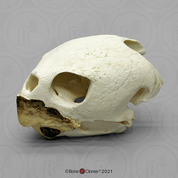

Synapsids have one set of lateral temporal fenestrae. Synapsids include mammals and their ancestors like us and Dimetrodon.

Diapsids have two sets of temporal fenestrae in their skulls. These include reptiles, dinosaurs and birds.
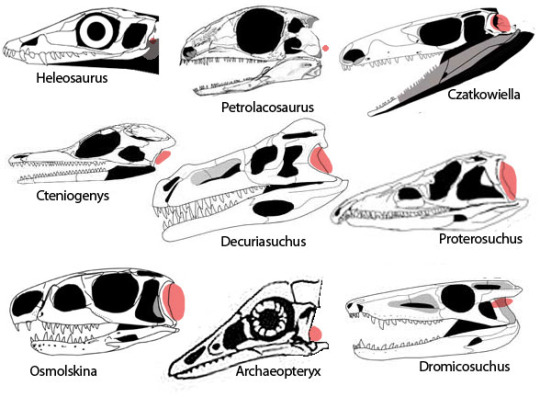
Other traits of amniotes include two pairs of sacral ribs (generally fused to the vertebra and the rest of the sacrum)
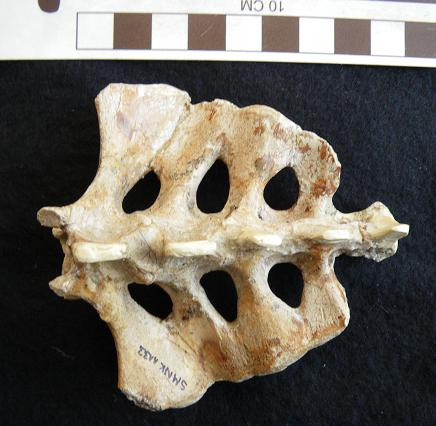
a sternum (some amniotes have lost this secondarily)

and an ankle bone called the astragalus.
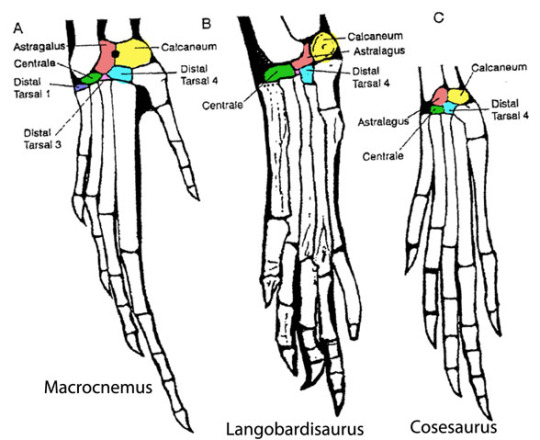
Now that we know a little bit more about amniotes, tune in tomorrow for some trivia! Fossilize you later!

#paleontology#fossils#fun facts#amniotes#eggs#reptiles#mammals#birds#dinosaur#anapsids#synapsids#diapsids#comparative anatomy#vertebrates#vertebrate anatomy
39 notes
·
View notes
Text
Chapter 1 - Seven Years
[Forward by the author]
The protagonist of our story was born like this:
At an engineering facility on a planet called Ceti, a Human named Dan Loris worked for an entity called Atom GeneWEAVE. He* was tasked with writing the genetic code of a variety of engineered humans and he composed them with the skill of a master musician, for a very particular brief. The first six attempts were not viable and his computer** simulations didn’t predict a favourable outcome for them. The seventh attempt, however, would work. He implanted this genetic code in a Human egg and fertilised it in an incubation chamber, and it began to grow.
Outside his facility, under the unknowable sky of mysterious Ceti, there was a great ship called The Lonely Sailor. This ship was larger than you could ever imagine, large enough to hold thousands of Humans and the requisite cargo to let them live on a new world long enough for them to become self-sustaining there. Measurements on record state that The Lonely Sailor was more than a kilometre long.
The Lonely Sailor was owned by Atom GeneWEAVE and would carry a cargo container full of fertilised Human eggs to the new world. These were known as embryos and were mostly held in a frozen state, but there were twenty of them which were not frozen. They were placed in false amniotic sacs and allowed to continue growing throughout the entire voyage of The Lonely Sailor, even though the adult Humans themselves would be frozen instead.
Dan Loris slotted his first viable attempt at life into the cargo hold last, knowing that it would be the first to wake. He used a computer machine called a Deep Dreamer to monitor the growing life, and encoded within it an operation called ‘Athletic_Boy_Childhood_03.deepdr‘. He wrote on the amniotic sac the name of his creation: Ishmael© property of ATOM GENEWEAVE®.
Dan Loris then settled himself into a sleeping chamber which would freeze him harmlessly for the duration of the voyage.
The journey from Ceti to Siren would take seven years. Ishmael grew from fertilised egg to embryo and then became a baby in the normal period of time that these things take. But he was not born then. He remained asleep, dreaming that he was living a Human childhood.
We can only guess at what he dreamed of, as the memory encoded into him was designed to fade, leaving behind only the lessons that Atom felt were necessary for him to learn, to function normally and not emerge from the seven year journey in a feral state. He learned how to speak, how to read and write, all without ever having taken a single breath. When he was old enough, he moved his body as though he were engaging in games of chase and team sports, and this allowed his muscles to develop.
Atom was as a deity to the Humans sleeping in The Lonely Sailor – Atom decided that they were going to Siren and they were not able to refuse. Throughout every source I could find, I never came across one that described what Atom was at its heart, only that it was unimaginably powerful and had bases on several planets.
Atom was so omnipresent, so all-encompassing, that no one thought to explain it, or question it, or even remark on its presence particularly often. The Humans worked for Atom. Ishmael and his cohort of engineered embryos were born to work for Atom. Working for Atom, it seemed, was the only reason for anybody to live in Precursor society, and they were utterly shackled to its side whether they liked it or not.
Atom chose Siren for three reasons: the atmosphere had the right sort of air and had grown its own plantlife; there used to be very extensive ice caps around North; and a rival entity known as The Authorities could not interfere with Atom on Siren. The writings of Dan Loris state several times that Atom held The Authorities in contempt, but they were the only force powerful enough to punish Atom for poor behaviour. Genetic engineering such that had been planned by Atom was not permitted by The Authorities, and Atom GeneWEAVE, the part of Atom responsible for it, wanted to work with projects which would be profitable in spite of their illegality in the eyes of The Authorities.
Despite the unclear nature of Atom and The Authorities, I believe this is a story which has been repeated time and time again throughout the centuries. Whom among us has never found a secret corner to hide our trespasses? This was a game of chase, and the only thing that motivated Atom, the thing which caused it to sink a considerable amount of resources on The Lonely Sailor, was the pursuit of profit on a scale so grand that the modern Sirenian can hardly comprehend it. And, in the face of this monumental scale of profit, it was hoped that the Authorities would be rendered ultimately powerless.
The Lonely Sailor arrived on Siren on the date ‘20/07/2378’, which I am sure was significant to the Precursors. For the sake of legibility I will refer to this year as Year 1, the first year of Humans on Siren. The Sailor found pleasant weather, low winds and a water level slightly raised from the baseline in West, where the settlement began. While this was noted by the meteorologists aboard The Sailor, they weren’t to know its significance, which any one of us will recognise immediately; West was recovering from a High Tide which must have taken place only months before.
The captain of the ship was a Human called Ivana. She* was the highest authority under Atom itself on the ship, and the first to wake from her frozen sleep. She gazed down at Siren from above and wrote her observations, which I can reproduce here following extensive translation work:
Beautiful morning on Siren. What I wouldn’t give to show Dad this. A career first! We will land in seventy-two hours after finishing our preliminary rotation and once the landing crew have walked off the brain freeze.
I assume ‘Dad’ is a significant other of some kind, perhaps deceased, judging by its absence.
The landing was described in a series of cargo logbooks and completed by a small crew which had been woken up from their sleep. Supplies were conveyed to a low mesa in West and within a matter of days the settlement was born. It was built out over the surface of the sea, anchored to the mesa with powerful brackets that remain today. Throughout the entirety of its existence, the Atom Settlement continued to grow outwards, so the very heart of it was the oldest, the bowers constructed to house the first crew. One of those very first bowers was the gene laboratory, which had been transported in its entirety from Ceti.
Dan Loris offloaded the embryo cargo pod thirty-nine days after landing, still in the first year. Five days later, Ishmael’s amniotic sac was drained, and his deep dream interrupted by his birth.
The last moment of his encoded dream was common to all artificial dreams, designed to ease the transition into true waking life. He was falling asleep in his bed (an archaic sort of bower), his body feeling tired but satisfied after a day of typical, perfectly generic childhood games. He had something called a mother in this dream who pulled the blankets around his shoulders and kissed him as he drifted off, though he did not remember what their face looked like, only that they instilled within him a sense of perfect safety.
His moment of calm was soon eaten by sensation. It was cold, he realised. Colder than anything he had ever felt. The fluid that had supported him at a constant temperature for seven years was draining away and he reached out, to grab at the blanket he half-remembered. His nerves were alight with new sensations and the world was so bright it felt that he was staring into Odr’s eye.
Dan Loris described him as strong and healthy, but Ishmael did not feel that way. Everything was loud and bright and his body was so heavy. He had never truly experienced gravity, but that alone did not account for the disconnect. His dream had been the dream of a Precursor Human, a bipedal creature with a fully upright stance, straighter even than a shortwing’s, with no tail, no flippers, no phocid morphology. To the newborn Ishmael’s mind, he had just undergone a horrifying transformation, and his body was wrong.
Modern selkies and phocids are likely to imagine a child similar to their own young, but this is not the case. Ishmael was unnaturally pale and almost colourless save for a growth of hair which was a light red. His skin was very thin and translucent, with no markings aside from a blue pictogram on one shoulder, a stylised Atom emblem which had been engineered to form from his own skin pigments.
He was large and heavy compared to Human children of the same age, with a long arched neck connected to his head at the back rather than the bottom as was normal for Humans and harpies, which made it difficult for him to stand upright and look forward without inviting neck pain. He had very large and powerful hands with short webbed fingers, and a combination of long torso and short legs which would help him walk on all fours and swim cleanly with his tail fluke. His arms were quite long in comparison to a modern phocid’s and, at this age, he was exclusively bipedal.
He was born with pale eyes which were white around a pink iris, though that changed over the years. The first things he saw—that he consciously remembered seeing—were his own fingers clamped over those eyes to block out the lights at the laboratory. He opened them a crack, so that the light shone through the pink webbing. It confused him—there wasn’t supposed to be webbing there. Humans (and phocids) do not have webbing between their fingers, after all.
He was curled in on himself on a cold hard surface, while somebody spoke in the background. It is a great blessing that the automatic transcriber machine is still intact today, and we can access the exact words spoken in the laboratory for the entirety of its existence. After lengthy translation work, it can be rendered intelligible to us. Later I will share the correspondences between myself and the anonymous linguist who so greatly aided me here.
“He’s a concept, Ivana, we’re not putting him in the water until we know for sure the probes were right about that sea out there. And I kind of want to leave the actual bodywork to the betas, y’know, Ishmael is just a precaution before we wake them up.”
“Could you turn down the lights a little? I’d have a headache too if I was staring up into those things for the first time,” said Ivana. She had come down to the lab out of curiosity, to see the first-born Human on Siren.
“I need to be able to observe every reaction,” Dan Loris said. “Ishmael will get used to it. Delayed births can cause absolute havoc if the modifications aren’t tuned properly.”
His hands, dry and shockingly cold, caught Ishmael’s blocky wrist. Dan Loris pried the webbed hand away from Ishmael’s eyes and shone a pen light in each. Ishmael’s eyes stung and burned and he tried to wriggle away, but Dan Loris took no notice of this.
He passed a heart scanner along Ishmael’s front and watched the live feed appear on a display window in the side of the lab. Ishmael was rapidly forgetting his dream childhood in the face of this confusing start, but he did remember, for a moment, a similar scene. The childhood deep dream that he had been given included a scene of hospitalisation, to acclimatise children to medical checks.
So the footage of his skeleton and pounding heart on the wall was oddly familiar, though the shape was wrong and freakish to him. His head felt light and dizzy and he, only seven years old, had no ability to reconcile what he saw and felt with what he thought to be true. When Dan Loris pushed the wet red hair away from Ishmael’s face, Ishmael tried unsuccessfully to bite him.
“Funny little guy, isn’t he?” Ivana said, leaning into his line of sight. “Why’d you make him so pale? Like a lab rat.”
Dan Loris snorted. His medical scissors snipped by one of Ishmael’s ear holes and sliced off a chunk of hair. “Why d’you think those are white, too? He’s not here to look pretty. The betas will have proper pigment, they won’t fry in the sun.”
It was at this point that it all became too much for Ishmael. He broke into a sobbing fit with remarkable suddenness and didn’t stop until Dan Loris clamped a mask over his nose and mouth which delivered a soothing air into his lungs. Ishmael’s eyelids drooped. He looked around for his mother and didn’t see one. Calmer, he sat on the examination table and watched over the rim of the mask as Dan Loris performed all manner of tests on him, most of which made no sense to him, and seemed pointless. Every joint was checked for smooth abduction and adduction. Skin scrapings were collected from his tail. They took his blood and his saliva, and every inch of his body was captured in image form by a roving, flashing device.
His first meal came next – a pouch of gel designed for people who had been born in similar circumstances, which might prepare a stomach that had been empty its whole life for the rigours of real digestion. He had been fed through a large blood vessel in the artificial amniotic sac, and not through an umbilical cord. As a result, he had no navel, and spent his first few days alternatively vomiting and crying as his digestive tract learned how to work.
Delayed birth, while preventing a young mind from being irrevocably damaged by sleeping through key developmental periods, was still no substitute for a true childhood when it came to mental development. Ishmael could speak and understand others, but he essentially entered life as an unusually well-educated infant in a large and overdeveloped body.
The accounts of his mental growth during his early years are somewhat sparing. There are abundant records of the tests in which he was forced to participate, the exact parameters of his growth, his weaning from gel to solid food, even records of each trip to the latrine. But nobody thought to record his mood or emotional state beyond “Ishmael was cooperative today” or “Ishmael needed sedation today”.
What I can tell you is that by age ten he stood at average adult Human height and just about average adult Human weight. He rarely spoke and gave little indication of understanding anything said around him either. By this time, the second generation of Sirenians, the beta generation, had been given their own delayed births. But Ishmael did not interact with them and it appeared that he knew very little outside the confines of the lab.
At this point in life, he met Dan Loris’s own fosterling, known as a biological child. This biological child was called Callum and he had not had a delayed birth. In fact, he had been in frozen sleep alongside Dan Loris himself. Although he was also ten years old, he had lived in total seventeen years, even if those seven extra years had passed in the blink of an eye and left no lasting impression on his body or mind. By all accounts, this was a far more ethical way to transport someone great distances on The Lonely Sailor.
Callum’s interactions with Ishmael are well recorded, and the earliest examples we have of Ishmael expressing any desires or opinions – the daily records began to include lines like “Ishmael asked about Callum” or “Ishmael was upset at Callum’s absence”. And while there are transcriptions of every word spoken within the lab, the record banks are so huge that it becomes difficult to sift through for any clues as to how Ishmael was developing internally during this time. It seemed, in any case, that he enjoyed the company of another child his age, which is only to be expected, and that he was able to ask to spend more time with his only friend.
There is another side to this. Among other records we located a diary of Callum’s. All of the Precursors were required to write reports of their weekly activities, and the children in particular were encouraged to keep journals, to discuss their emotional reaction to the great upheaval in their lives, and their imaginings of an Atom-controlled future on this new world. Callum’s diary spans his teenage period, not this earlier time, and we will delve into its contents in a later chapter. But it does mention that, at age 10, Callum was wary of Ishmael, and that after a series of incidents which are poorly described but culminated in Ishmael pulling the laboratory door off its hinges, Callum no longer felt safe in his presence.
Indeed, the incidence of “Ishmael was sedated today” in the record logs increased quite dramatically at around this time. A reason is never explicitly stated but I would make an educated guess that Callum, growing more uncomfortable, was not spending as much time with Ishmael, causing distress in the latter. Ishmael was prone to tantrums, often wordlessly lashing out and, on the aforementioned occasion, breaking a door.
Ishmael himself was never consulted to determine the cause of these incidents, with all indications being that the lab workers did not believe him articulate enough to bother reasoning with. As anyone who has spent a season in the nursery knows, underestimating a child’s ability to understand on some level precisely what distresses him is a fool's error.
At the age of eleven, the tantrums had clearly become dangerous, given the damage to the lab infrastructure and Callum’s unwillingness to spend time with Ishmael. Ishmael was growing physically powerful in a way that had not been anticipated by his creator. It may seem surprising, but the art of genetic engineering was never so simple as merely picking and choosing what traits to instil in an embryo. As Dan Loris noted, the science was still relatively new, and their techniques, while powerful, were not precise enough to predict every single possibility. Thus the need for refining a design over concurrent generations, and for producing one-off ‘alpha’ variants like Ishmael himself. Either way, Ishmael was showing a tendency towards gigantism which had not been anticipated.
Management plans had to be drafted, and Dan Loris records the first ever instance of an attempt to understand Ishmael on an emotional level. He brought in a Human called Maris to talk to Ishmael once a day, in the hopes that it would calm him and provide some insights into his psyche. The notes of Maris are an invaluable resource, providing the most detailed written accounts of Ishmael’s childhood, which even Ishmael himself did not adequately record (citing trauma and personal distaste as his reasoning).
She also captured moving ‘video’ images of Ishmael during these sessions which I have been able to access. If not for these, critical moments and historical figures in Siren’s history may have been lost to time forever, leaving nothing but a dry tally of facts recording Ishmael’s physical parameters, as though he were little more than livestock.
*Humans refer to themselves as ‘he’ or ‘she’. I will leave this untranslated as I believe those are different enough to be significant to this society. Based on my studies of Atom society I believe that their usage of 'he' is entirely unrelated to its modern-day counterpart.
**it is my understanding that a computer is a type of machine which can receive information fed to it by a person and produce a mathematical calculation based on that information which the person can interpret, or cause another machine to perform a specific operation – this was used for every facet of Precursor life to automate their machinations, from food production to predicting the outcome of specific events. We may be more familiar with computers in the form of harpy visors though these could be of almost unlimited use.
#setting: siren#there ya go. needless to say our guy had a rough start and a rough middle and also a rough ending#writing tag
70 notes
·
View notes
Text
The egg cell (the female gamete that combines with a sperm cell to form the zygote) and the two synergid cells are located at the micropylar end of the embryo sac and are collectively referred to as the egg apparatus (Figure 21.9).
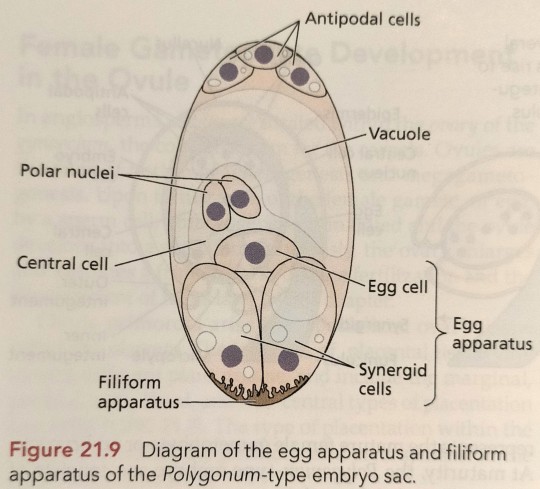
"Plant Physiology and Development" int'l 6e - Taiz, L., Zeiger, E., Møller, I.M., Murphy, A.
#book quotes#plant physiology and development#nonfiction#textbook#egg cell#gamete#zygote#synergid cells#micropylar#embryo sac#egg apparatus#plant cells#polygonum#filiform
1 note
·
View note
Text
At maturity, the Polygonum-type embryo sac consists of seven cells and eight nuclei.
"Plant Physiology and Development" int'l 6e - Taiz, L., Zeiger, E., Møller, I.M., Murphy, A.
#book quote#plant physiology and development#nonfiction#textbook#maturity#polygonum#embryo sac#plant cells#nuclei#plant reproduction
0 notes
Text
A new study using stem cell-based models has shed new light on how the human embryo begins to develop, which could one day benefit the development of fertility treatment. The study led by the University of Exeter Living Systems Institute has revealed how early embryo cells decide between contributing to the fetus or to the supporting yolk sac. The paper is titled "Naive pluripotent stem cell-based models capture FGF-dependent human hypoblast lineage specification" and is published in Cell Stem Cell. Understanding this decision is important because the yolk sac is essential for later development in the womb. Producing the right number of yolk sac forming cells may be critical for infertility treatment using in vitro fertilized (IVF) embryos.
Continue Reading.
48 notes
·
View notes
Text
this wip scene is like, a few chapters down the line in my 1999 fic but it was one of the chapters i wrote first bc my mind was like "i want drifter to have a helminth charger in 1999 but it being done in the dumbest way possible" and so this was born.
i want you to know that drifter was yelling loud enough that yes, the hex heard them, and yes, they are very confused as to wtf is going on in the backrooms sometimes (there will be awkward questions)
(CW: this has helminth in it and usual infested grossness so, if helminth regurgitating stuff, etc, squick you then... yeah)
-
Helminth heaved and gurgled, its entire being convulsing as it forced out… something… from its mouth - a big sac of slimy flesh, wriggling from its thrashing contents. Drifter could only stand there, open-mouthed and morbidly fascinated, as Helminth vomited- regurgitated? - GAVE BIRTH??!?!??!
“Uh, what-” Drifter said faintly.
The meat sac - embryo??? - HELMINTH’S BABY?!?!? - was coughed up onto the cold, hard floor with one final, heaving gasp from Helminth. A thin cord, like an umbilical, wound up from the sac wriggling on the floor and into Helminth’s quivering maw - again, Helminth started to retch, heaving and gasping until-
“Um,” Drifter said.
-something like afterbirth was hurled out of the creature’s mouth, hitting the ground next to the meat sac. Helminth panted from exertion, and Drifter just stood there, unsure on how to feel about what they just witnessed. Disgust? Amazement? Should- was Drifter supposed to, like, help Helminth’s………. b.……….. Baby???????? Should they- whu- huh- but- wait- Helminth- baby??? Helminth had a baby????? HELMINTH WAS-
“PREGNANT?!” Drifter shrieked, the shock finally catching up to them. They pointed at the wriggling sac. “Helminth?! Who- who’s baby is this?!”
“(Yours… my gift, to y-)”
“WHAT DO YOU MEAN MINE!?!?!?”
“(Carry it, I did, for-)”
“I DIDN’T MAKE YOU PREGNANT!”
“(Demon… listen-)”
“WAS IT UMBRA?!”
Drifter didn’t get their answer (HELMINTH AND UMBRA BABY?!?!?!). A wet, gristly tear of meat and flesh cut through the air, and Drifter looked down to see a clawed hand flail madly out of its embryonic sac, followed by pitiful and confused whines.
“Oh- oh shit, oh.” Drifter floundered, but the whines were at that pitch that triggered Drifter’s ‘something small and vulnerable is in trouble I need to help’ instincts, and they quickly knelt in the gross puddle of viscous fluid and bile Helminth had vomited up along with its baby(?!?!?!?), carefully peeling the clinging sac away and slowly revealing the creature within: some sort of… thing.
“(Kubrow),” Helminth said.
“Hah?” Drifter said. The thing - Kubrow- an infested Kubrow? Stared(?) up at it with glowing… not-eyes. Slits. And it's... not-mouth split open to reveal a... lot of mouth tentacles and... proboscis and... hrm.
Wait.
“You got impregnated by a Kubrow?” Drifter said dumbly.
“(EGG.)”
“Egg?????”
(“Demon… you fed me Kubrow egg… I keep, for gift for you…)”
…
……
………
…………
“OH!” Drifter exclaimed, realisation like a blissful thunderstrike of utter relief. “OH! OH I GET- OH!”
“(Yes.)”
“So not- not baby! You- incubator!”
“(Yes.)”
“Oh, okay, haha, that’s… oh thank fuck.”
#warframe#warframe 1999#drifter warframe#helminth#fanfic#the backrooms is the comedy show between drifter helminth and umbra#if ordis was there the comedy quartet would be complete#me like: i enjoy writing angst and umbra drifter and arthur are a goldmine for it#also me: hehehe (puts clown make up on them)#really you need some absurd moments to go with the angst for the breathing space#that precious tension and relief
12 notes
·
View notes
Text

Xenomorph : Cantos 13 Strain - Brood Host
An isolated branch of the xenomorph family tree named after the colony world of it's discovery, the Cantos 13 Strain is a strange and insidious organism.
The Brood Host is created when a Palliumite successfully secures a host for impregnation and begins the process of converting their body for mass brood production.
The Palliumite will shed hive mucus upon a chosen area to place the host body, preferring a surface thats difficult for any threats to reach it. The parasite will then remove any extremities the host may use to defend itself (if they were not already docked during the carrying process) via acidic application. With the initial coupling, the host will have been heavily paralyzed to ensure no resistance, but post-limb removal the paralysis is no longer used. Once all is prepared, the Palliumite will re-attach and begin pumping the host body with morphogenic hormones. Over some days the host will have their torso heavily bloated and extended into a thorax-like sac containing many immature xenomorph embryos. The host body lacks an orifice to release these organisms, so the Palliumite surgically cuts them open with it's bladed legs so the newborns may slowly drop from their umbilical cords like a slow-motion macabre rain. The Palliumite well then close the birthing wound and reseal it with cauterizing acid and hive mucus.
The Brood Host will be kept alive as long as possible by the Palliumite and the Whistlers it birthed, lasting for years until it can last no longer. During this whole process the Brood Host is groggily aware of their situation, kept in a drugged up dream state by the Palliumite to keep their vitals stable. The reason for this awareness is for security, as if intruders enter the brooding chamber the Brood Host may hear them and attempt to call for help, alerting the Palliumite to the threat which begins to rub its limbs like a cricket to call Whistlers to it's aid.
257 notes
·
View notes
Text
Round 2 - Chordata - Actinistia


(Sources - 1, 2)
The Sarcopterygians (“Lobe-finned Fishes”), are the last of the three groups of “fish”, and are so named for the prominent muscular limb buds (lobes) within their fins. Of the Sarcopterygians living today, they are represented by the coelacanths, lungfish, and tetrapods (including humans), who all diverged in the Silurian. These next fish are closer related to us than they are to Actinopterygiians.
The class Actinistia, the “Coelacanths”, are an ancient group of fish that have been around since the Devonian but today are only represented by two remaining species: The West Indian Ocean Coelacanth (Latimeria chalumnae) and the Indonesian Coelacanth (Latimeria menadoensis).
Coelacanths can live as deep as 700 m (2,300 ft) below the sea, but are more commonly found at depths of 90 to 200 m (300 to 660 ft). They have sensitive eyes which include a tapetum lucidum and many rods which help them see better in dark water, as they are most active at night. They are opportunistic hunters, feeding on cuttlefish, squid, snipe eels, small sharks, and other fish found around their deep reef and volcanic slope habitats. Their abundance of fins allow for high maneuverability, and coelacanths can orient their body in almost any direction in the water. They have been seen doing headstands as well as swimming belly up. They are able to slow their metabolisms at will, sinking into less-inhabited depths and going into a hibernation mode to conserve energy.
Coelacanths are ovoviviparous, with the female retaining the fertilized eggs within her body while the embryos develop over a gestation period of five years. The female will give live birth to around 5-26 young. Young coelacanths resemble the adult, but carry an external yolk sac below their pelvic fins, and have larger eyes relative to body size. Individual coelacanths may live as long as 80 to 100 years.
Coelacanths get their name from Coelacanthus, a genus of Permian coelacanths and the first coelacanths to be described. Over 100 fossil species are known, and all of them were believed to have gone extinct in the Cretaceous. On December 23, 1938, the first Latimeria specimen was discovered among the catch of a South African fisherman, making coelacanths a “lazarus taxon.” While previously considered a “living fossil”, coelacanth body shapes were much more diverse in the Early Triassic, and Latimeria is not known from fossils, showing that it had to have gone through some changes to adapt to the modern day.

Propaganda under the cut:
Since there are only two living species in this class and both are threatened, this is the most endangered class of animals in the world.
Coelacanths get along with other coelacanths, though they recoil from physical touch. Scientists think that they recognize each other via electric communication.
Mawsonia was one of the largest known coelacanths, with one specimen estimated at over 5 m (16 ft) long. It lived from the Late Jurassic to Mid-Cretaceous.
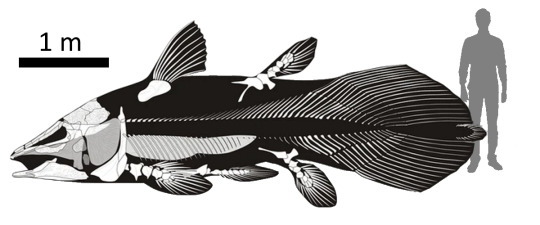
(source)
90 notes
·
View notes